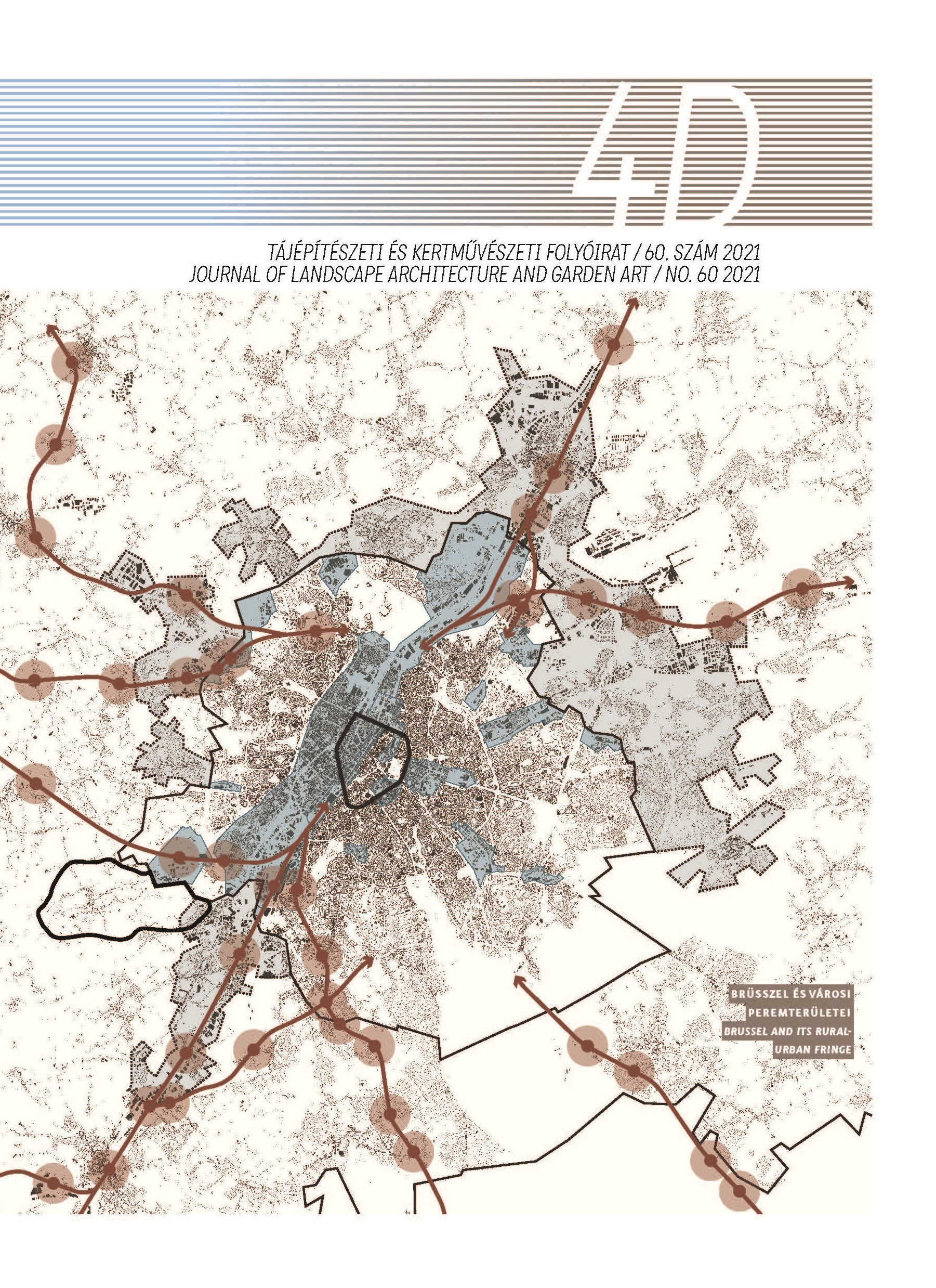Perceptional analysis of the role of individual trees in the urban image
DOI:
https://doi.org/10.36249/60.5Keywords:
cultural ecosystem services, urban trees, cityscape, perceptional surveyAbstract
Urban trees are an important part of urban image, character and cityscape, and the ecosystem services they provide have been extensively studied. However, years after the introduction of new urban image protection and urban design tools in Hungarian practice, the importance of individual trees is still a relatively obscure topic in research. In our research, we studied which individual trees are the most prominent within a study area in Southwestern Budapest using a perception-based method. 74 participants were asked to walk through the study area and choose a maximum of 10 individual trees that they considered the most impactful in their surroundings from an urban image standpoint. The results show that while a very wide variety of trees were chosen by at least one person, certain trees received significant amounts of votes, with some being selected by more that 20% of participants. Our results suggest that people with and without a profes[1]sional background concerning trees had similar opinions, with some differences. Our research shows that – contrary to traditional, maintenance-centered tree evaluation methods –, the species and health condition of individual trees are less significant features from an urban image standpoint. On the other hand, location and contrast – in colour or form – are highly important.
References
MSZ 12042:2019 Fák védelme építési területeken. Budapest: Magyar Szabványügyi testület. [online] In: Magyar Szabványügyi Testület honlapja. URL: https://ugyintezes.mszt.hu/Publications/Details/172822 [2021. 07. 30.]
MSZ 12172:2019 Díszfák és díszcserjék ültetése települések közterületein. Budapest: Magyar Szabványügyi Testület. online] In: Magyar Szabványügyi Testület honlapja. URL: https://ugyintezes.mszt.hu/Publications/Details/172821 [2021. 07. 30.]
SZAKÁCS B. (ed) (2018): Zöldinfrastruktúra füzetek 4: Városi fák és közművek kapcsolata. Tervezési útmutató. Budapest: Főváros Főpolgármesteri Hivatal. URL: https://docplayer.hu/ [2021. 07. 30]
SZAKÁCS B. (ed) (2021): Zöldinfrastruktúra füzetek 6: Fahelyek és zöldsávok védelme a városi utak mentén. Budapest: Budapest Főváros Főpolgármesteri Hivatal.
Bp FATÁR adatbázis és applikáció. Budapest: Főkert ZRt. [online] In: Főkert honlapja. URL: https://www.fokert.hu/bpfatar/ [2021. 07. 30.]
Faértékszámítás. [online] Érd: Magyar Faápolók Egyesülete. In: Magyar Faápolók Egyesület honlapja. URL: https://faapolok.hu/faertekszamitas/ [2021. 07. 30.]
SZALLER V. (ed) (2013): Útmutató a fák nyilvántartásához és egyedi értékük kiszámításához. Magyar Faápolók Egyesülete: Budapest. URL: https://faapolok.hu/
GERSTENBERG, T. – HIFMANN, M. (2016): Perception and preference of trees: A psychological contribution to tree species selection in urban areas. Urban Forestry & Urban Greening, 15, 103-111. DOI: https://doi.org/10.1016/j.ufug.2015.12.004
López Arce, – Miguel Ángel (1975): El cálculo de indemnizaciones derivadas de la pérdida de árboles ornamentales. ICONA: Madrid.
JÓSZAINÉ PÁRKÁNYI I. (2005) A közcélú zöldfelületi vagyon értékelésének metodikai lehetőségei és használata a település gazdálkodásban. Tájépítészet, 6(2), 16-22.
Asociación Española de Parques y Jardines Públicos (2007): Método para valoración de árboles y arbustos ornamentales: Norma Granada: revisión 1999. Asociación Española de Parques y Jardines Públicos: Madrid, Spain.
LTOA (London Tree Officers Association) (2012): Capital Asset value for Amenity Trees (CAVAT). URL: https://www.ltoa.org.uk/documents-1/ [2021. 07. 30.]
HEGEDÜS A. – GAÁL M. – BÉRCES R. (2011): Tree appraisal methods and their application - First results in one of Budapest’s districts. Applied Ecology and Environmental Research, 9(4), 411-423. URL: https://www.aloki.hu/pdf/0904_411423.pdf
Lechner Tudásközpont Területi, Építészeti és Informatikai Kft. (2017): Útmutató Településképi Arculati Kézikönyvek Készítéséhez. Budapest.
CONSTANZA, R. – D’ARGE, R. – DE GROOT, R. et al. (1997): The value of the world's ecosystem services and natural capital. Nature, 387, 253–260. URL: https://www.nature.com/
Millennium Ecosystem Assessment (MEA) (2005): Ecosystems and Human Well-being: A Framework for Assessment. Island Press: Washington, DC. URL: https://www.millenniumassessment.org/documents/document.356.aspx.pdf
CHENG, X. – VAN DAMME, S. – Li, L. – UYTTENHOVE, P. (2019): Evaluation of cultural ecosystem services: A review of methods. Ecosystem Services, 37, Article 100925. DOI:https://doi.org/10.1016/j.ecoser.2019.100925
WALLACE, K.J. (2007): Classification of ecosystem services: Problems and solutions. Biological Conservation, 139(3–4), 235–246. DOI: http://doi.org/10.1016/j.biocon.2007.07.015
ABUALHAGAG, A. – VALÁNSZKI I. (2020): Mapping indicators of Cultural Ecosystem Services: Review and relevance to urban context. Journal of Landscape Ecology, 13(1), 4-24. DOI: https://doi.org/10.2478/jlecol-2020-0001
HERNÁNDEZ-MORCILLO, M. – PLIENINGER, T. – BIELING, C. (2013): An empirical review of cultural ecosystem service indicators. Ecological Indicators, 29, 434–444. DOI: https://doi.org/10.1016/j.ecolind.2013.01.013
BLICHARSKA, M. – SMITHERS, R.J. – HEDBLOM, M., et al. (2017): Shades of grey challenge practical application of the cultural ecosystem services concept. Ecosystem Services, 23, 55-70. DOI: http://dx.doi.org/10.1016/j.ecoser.2016.11.014
TENGBERG, A. – FREDHOLM, S. – ELIASSON, I. (2012): Cultural ecosystem services provided by landscapes: Assessment of heritage values and identity. Ecosystem Services, 2, 14–26. DOI: http://dx.doi.org/10.1016/j.ecoser.2012.07.006
Council of Europe (2000): European Landscape Convention. ETS No. 176. Council of Europe Publishing Division: Strasbourg
Brown, G. – Fagerholm, N. (2015): Empirical PPGIS/PGIS mapping of ecosystem services: a review and evaluation. Ecosystem Services, 13, 119-133. DOI: https://doi.org/10.1016/j.ecoser.2014.10.007
VALÁNSZKI I. – FILEPNÉ KOVÁCS K. (2018): PPGIS módszer alkalmazhatóságának vizsgálata különböző táji értékek azonosítására. Tájökológiai Lapok, 16(1), 13-22. URL: http://real.mtak.hu/82532/1/02_Valanszki_Filepne_u.pdf
PLIENINGER, T. – DIJKS, S. – OTEROS-ROZAS, E.– BIELING, C. (2013): Assessing, mapping, and quantifying cultural ecosystem services at community level. Land Use Policy, 33, 118–129. DOI: http://doi.org/10.1016/j.landusepol.2012.12.013
BUBALO, M. – VAN ZANTEN, B.T. – VERBURG, P.H. (2019): Crowdsourcing geo-information on landscape perceptions and preferences: A review. Landscape and Urban Planning, 184,101-111. DOI: https://doi.org/10.1016/j.landurbplan.2019.01.001
Downloads
Published
Issue
Section
License
Copyright (c) 2021 László Nádasy, Valánszki István

This work is licensed under a Creative Commons Attribution-NonCommercial-NoDerivatives 4.0 International License.
A folyóirat Open Access (Gold). Cikkeire a Creative Commons 4.0 standard licenc alábbi típusa vonatkozik: CC-BY-NC-ND-4.0. Ennek értelmében a mű szabadon másolható, terjeszthető, bemutatható és előadható, azonban nem használható fel kereskedelmi célokra (NC), továbbá nem módosítható és nem készíthető belőle átdolgozás, származékos mű (ND). A licenc alapján a szerző vagy a jogosult által meghatározott módon fel kell tüntetni a szerző nevét és a szerzői mű címét (BY).



